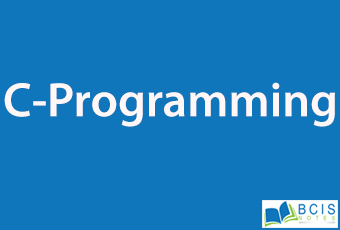
C Programming Language
C is a programming language developed by Dennis Ritchie at the bell laboratories in the mid-1970s. A c programming language is a high-level language, which seems popular because C programming language is reliable, simple and easy to use. It is designed to have both, good programming efficiency and good machine efficiency.
Advantages of C Programming
- It is easy to learn.
- It is portable, we can easily transfer a program written in C from one computer to another computer.
- It is a faster and efficient programming language than other high levels ( 4GL ) languages.
- Supports structured programming, which means the problem might be solved in terms of functions modules or blocks.
- Adding new features is easy and faster.
- It is relatively near to the low-level language, hence it is easier to interact with hardware.
Disadvantages of C Programming
- The programs take more time to design, implement to the software.
- C coding techniques sometimes result in repeating code in time.
- C does not have an efficient garbage collection.
- It doesn’t contain run-time checking.
- It does not support object-oriented programming(OOP) features, so to overcome C++ language was introduced.
Structure of C program
1. Preprocessor
This is a part of the compiler which performs preliminary operations (conditionally compiling code, including files, etc).
2. Comment
It is the extra information that is not a part of a real program.
3. Function
It is a basic block of the program.
<stdio.h> = standard input output header file
4. Statements/Expression
A statement is a command given to the computer that instructs the computer to take a specific action, such as a display to the screen, or collect input. A computer program is made up of a series of statements.
5. Variables
Variables are the name which can hold different data.
# Parameter
The term parameter refers to any declaration within the parentheses following the function name in a function declaration or definition; the term argument refers to any expression within the parentheses of a function call.
# Data Type
A data type is an instruction that is used to declare the category or type of variables being used in the program. There are 5 types of data.
String
Integer
Float
Character
Void
String
A C-string is a character sequence stored as a one-dimensional character array and terminated with a null character.
Example:
strcpy(str1, str2);
Integer
The integer data type only supports integer numbers. It does not support decimal numbers and functionals numbers. it consumes 2 bytes of a memory location.
Example:
int a=5;
Float
The float data type supports integer numbers as well as it supports decimal and functional numbers. it consumes 4 bytes of a memory location.
Example:
float a=5.6;
Character
The character data only supports the character. it consumes 2 bytes of a memory location.
Example:
char ‘a’;
Void
A void is the data types that have no value. It is used as written types for functions that do not return a value.
Example:
void main()
Simple Example of C Programming
#include<stdio.h>
void main()
{
printf(“HELLO WORLD);
}
you may also like Operator, Header File

Leave a Reply